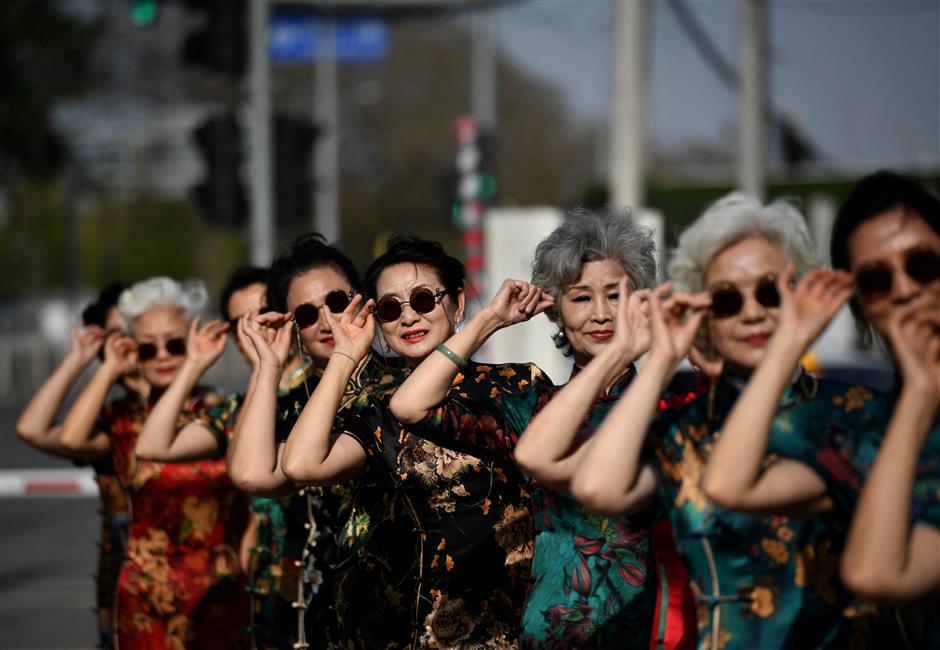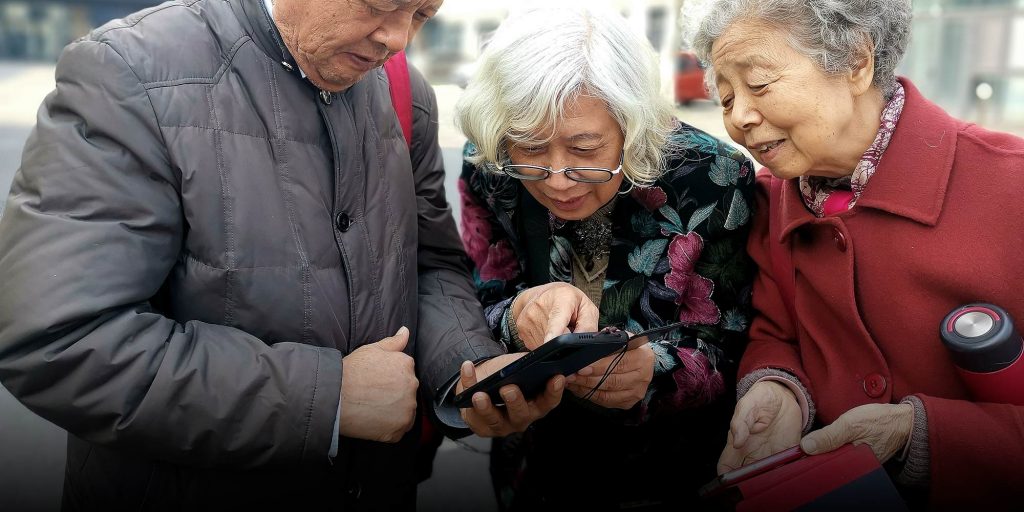Ageing In The Digital Era: China’s Elderly Lead The Way
In the heart of the digital revolution, a surprising demographic emerges as a pivotal player in China’s evolving digital landscape – the elderly. Long perceived as technology-averse, this group is defying stereotypes and embracing the digital age with unprecedented enthusiasm. As China grapples with the implications of a rapidly aging population, it becomes crucial to understand not just the challenges but also the opportunities this demographic shift presents. This article delves into the transformation of the elderly in China from traditional consumers to digital savants, exploring their profound impact on the digital economy, changing lifestyles, and the market for elderly-centric products and services. We will navigate through their journey from demographic overview to digital prowess, highlighting how they are not just adapting to but also shaping the digital future.

Demographic Overview
China is witnessing a significant demographic transformation, with over 280 million citizens aged 60 and above, making up 20% of its population. By 2035, the expenditure of those aged 60 to 74 is anticipated to reach a staggering $750 billion annually, marking a more than 50% increase from 2020 levels. This surge in spending capacity signifies a shift towards an older, more affluent demographic, fundamentally altering the consumer landscape. This transformation is largely attributed to urbanization and changes in family structures, particularly in the wake of the one-child policy, reshaping the country’s socio-economic fabric. (Source: 36kr)
The implications of this aging demographic extend far beyond the surface, challenging existing support infrastructures and exerting pressure on pensions, healthcare, and eldercare systems, while simultaneously introducing labor shortages in crucial sectors. This shift also prompts a reevaluation of marketing strategies traditionally focused on younger demographics, as the growing economic influence of the elderly becomes too significant to overlook.
The New Elderly Consumer
As we examine demographic change in more detail, it becomes crucial to explore the defining characteristics of the new older consumer. This group marks a stark departure from their predecessors, distinguished by their wealth, education, and digital engagement. Unlike any generation before them, the elderly consumer in China today presents a contrast so stark it redefines the archetype. Affluent, educated, and technologically adept, this new breed of seniors has emerged from the economic liberalization of the 1980s and 1990s, armed with substantial financial resources and a profound grasp of the digital landscape.
This significant evolution transcends mere differences in lifestyle or spending power; it challenges the conventional wisdom about aging and consumption in China. Today’s senior demographic is as dynamic and diverse as any other age group, defying outdated stereotypes. The transformation is vividly embodied by individuals like the 60-year-old fashionista ‘Sister Ma,’ who represents the changing face of wealth and influence in China’s aging society. Such examples underscore the depth and breadth of change among China’s elderly, highlighting a shift that is reshaping societal perceptions and market dynamics alike.
Changing Attitudes and Lifestyles
This evolution in demographics heralds a transformation in lifestyles and attitudes, where today’s elderly are charting new territories in how they live, spend, and engage with the world around them. This shift is vividly illustrated in recent years, as we observe a profound change in the day-to-day lives of China’s elderly population. No longer confined to the traditional ethos of frugality and home-centeredness that once defined their generation, today’s seniors are stepping into a more adventurous and resourceful way of life. This significant departure from their erstwhile reputation for conservatism is not merely a personal choice; it reflects a broader change in societal norms and expectations. Empowered by increased disposable income and more free time, this generation is seizing new opportunities for enjoyment and self-expression, embracing their golden years with an unprecedented zest for life.
Health and wellness have become focal points for this demographic, with an increasing emphasis on maintaining physical well-being and appearance. Elderly individuals are now more inclined to invest in healthy foods, supplements, and beauty treatments, indicating a growing consciousness about health and aesthetics alike. This shift is not just about living longer but living better, with a clear focus on quality of life that extends into financial planning and wealth management to secure a comfortable retirement.
Moreover, there’s a noticeable trend towards independent living, with a growing preference for senior homes and upscale retirement facilities. These establishments offer a blend of comfort, convenience, and community, catering to seniors seeking to enjoy their later years in style. The transformation of luxury hotels into elegant senior living spaces underscores the demand for sophisticated living options that cater to the diverse needs and preferences of the elderly.

Elder Products and Lifestyle Needs
As lifestyles evolve, so too do the needs and preferences of the elderly, driving demand for products and services that cater specifically to this demographic’s desire for independence, health, and comfort. The market for products and services tailored to the elderly is thriving, driven by a demand for solutions that enhance daily living and ensure safety and comfort. Home modifications for accessibility, assistive technologies, and personalized healthcare products are in high demand, reflecting a society that values independence and dignity in aging. Innovations such as handrails, ramps, and smart home technologies facilitate mobility and foster an environment where seniors can live autonomously.
Domestic and international companies are at the forefront of this burgeoning market, developing products and services specifically designed for the elderly. From Songzi Innovation’s smart home solutions to Suncare Group’s healthcare products, businesses are recognizing the unique needs of this demographic. Global brands like Philips and Kimberly-Clark are also contributing with medical devices and personal care items, highlighting the universal importance of catering to the elderly market.
Digital Engagement and Economic Participation of the Elderly
Central to the lifestyle transformations of China’s elderly is their rapid embrace of digital technology, a trend that shatters the stereotype of this demographic as technologically averse. Remarkably, from 2016 to 2022, the number of senior internet users in China leaped from 30 million to 153 million. This surge not only highlights their expanding online presence but also illustrates a profound shift in how the elderly interact with the digital world. Today, seniors are not just passively browsing the web; they’re spending upwards of four hours daily engaging with digital content. Their interests span across instant messaging, e-commerce, and short video platforms, with adoption rates surpassing 80% in these areas. (Source: China Briefing; JingDaily)

This enthusiastic digital engagement signifies more than a mere adaptation to modern technologies; it heralds the emergence of the elderly as pivotal influencers within the digital economy. Their adept use of the internet has led to the rise of ‘hyper online’ seniors who are reshaping China’s digital landscape. Noteworthy is the role of senior influencers, such as ‘High Heel Grandma Wang,’ who have demonstrated the potent influence of the elderly in digital marketplaces, amassing significant earnings through livestream sales.
The increasing prominence of the elderly in digital realms, particularly in e-commerce and live streaming, has not gone unnoticed by major tech firms. The accelerated growth rate of senior users on e-commerce platforms, outpacing other age groups by 30% in 2020, prompted a strategic shift.(Source: McKinsey) Recognizing the unique needs and preferences of this demographic, companies like Baidu, Didi, Taobao, and JD have launched senior-friendly applications. These initiatives, which emphasize simplified navigation and enhanced accessibility, not only cater to the digital fluency of the elderly but also leverage their substantial economic influence. By tailoring services to meet the demands of this demographic, tech companies are acknowledging and amplifying the significant role seniors play in the digital economy.
Strategies for Brands to Engage the Elderly Market
With the elderly’s proven digital engagement, brands face the critical task of developing strategies that resonate with this demographic’s unique preferences and values, underscoring the importance of trust, loyalty and digital accessibility. So, brands seeking to engage with the elderly market must prioritize trustworthiness and loyalty in their strategies. Understanding the value placed on reliable sources and consistent quality can help brands foster lasting relationships with this demographic. Tailoring marketing efforts to align with the values and interests of the elderly, particularly in health and wellness, can enhance relevance and appeal.
Moreover, the digital proficiency of today’s seniors offers an opportunity for brands to innovate in how they interact with this demographic. User-friendly digital interfaces and accessible customer service are essential, ensuring that the elderly feel supported and valued in the digital ecosystem. As the market continues to evolve, brands that can effectively address the unique needs and preferences of the elderly will find themselves well-positioned to succeed in this growing segment.
Conclusion
As we reflect on the dynamic role of the elderly in shaping China’s digital future, it’s clear that their journey is not just a testament to adaptability but also a beacon for what’s possible in an inclusive digital age. The elderly in China are not merely adjusting to the digital age; they are at the forefront, carving out a niche that resonates with their unique needs and preferences. This seismic shift in consumer behavior underscores a broader societal transformation, where age is no longer a barrier to digital engagement but a bridge to new opportunities. As brands and businesses recalibrate their strategies to cater to this digitally savvy demographic, the implications are far-reaching, signaling a paradigm shift in how we perceive aging and technology. The elderly, once seen as the periphery of the digital revolution, are now central to its progression, embodying a vibrant testament to the ageless spirit of adaptation and innovation. In embracing this change, China not only champions a more inclusive digital economy but also sets a global precedent for aging in the digital era. As we look to the future, it’s clear that the elderly are not just walking towards the digital horizon; they are leading the way.
Want to expand to the Chinese market? Contact us for a first free consultation.
